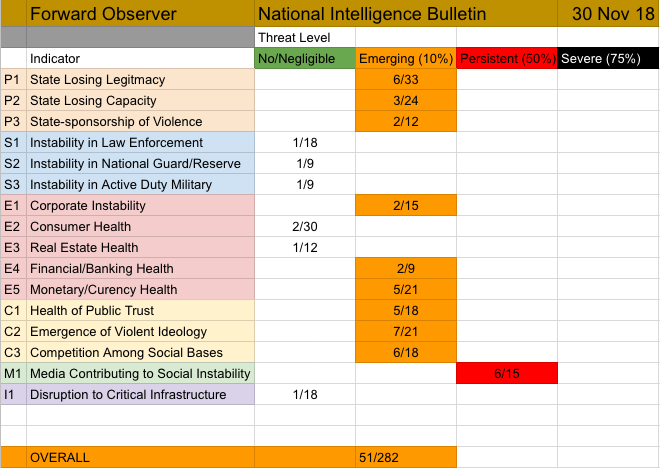Happy December, everyone.
In last week’s Dispatch, I promised more information FO’s new National Conflict Early Warning System.
We’ve been using it to track the potential for political and governmental crises, the outbreak of violence and conflict, and economic or financial disruption.
Why Early Warning?
Many of us intuitively sense that there’s a huge downside risk to social, political, and economic stability over the next months and years.
But when will we see it? Are we already seeing it? Just how bad can things get?
It’s easy to ask these questions, but much more difficult to answer them.
Yet that’s exactly what I set out to accomplish.
As consumer of information, I know you don’t need more headlines.
You need to maintain situational awareness on developing or deteriorating conditions.
You need to gain a sense of what future conditions might look like. You need to know when to expect that future to materialize. And you need timely updates in an easily consumable format.
In short, you need something actionable.
And the National Intelligence Bulletin, along with our new early warning system, delivers exactly this.
Each week, we look at 16 sectors where significant risk is present or could develop. (You can sign up to receive this insight, perspective, and analysis here.)
We use these 16 sectors to identify structural issues contributing to instability that could lead to systems disruption, unrest, or violence.
We identify the accelerators driving these trends. And then we look at potential triggers.
What could produce a ‘black swan’ type of event? What might be a point of no return?
And then this information is compiled into the National Intelligence Bulletin. If you’re not already a subscriber, you can receive timely warnings, insights, and analysis here.
Here’s a quick look at part of this process. The chart below shows the 16 sectors and then a gauge of the threat level to each sector. As several days ago, 30 November (when we first published it), there were emerging threats to most of the sectors. Based on the trends, there’s likely to be a lot more red on this chart over the next two years.
Sectors with scores in the Persistent to Severe range are more likely to trigger disruption, unrest, or violence.
By tracking these scores over time, we can pinpoint the exact condition that’s worsening, and then draw conclusions about the trajectory and its possible second- and third-order effects.
That allows us to reduce uncertainty about the future. And it provides our subscribers early warning of what could happen in the future.

I do see a developing domestic conflict. Unlike tanks and bombers from previous wars, this conflict will likely be marked by widespread low level violence more akin to a gang war than a conventional war.
That’s why we call it “low intensity conflict” — it’s the gray area under a conventional war but above routine, peaceful competition. And it could last for years or decades, with the risk of developing a higher intensity.
Make 2019 the year you stay on top of these threats. Use our intelligence to gain a better picture of potential local or regional conflicts. And most importantly, prevent surprise over conditions that could have been foreseen.
Sign up to receive our daily and weekly reports plus our monthly live intelligence briefs (new for 2019) right here.
Until the next Dispatch…
Always Out Front,
Samuel Culper
Director of Intelligence
Forward Observer
Director of Intelligence
Forward Observer
P.S. – These tectonic shifts in culture and politics are leading to an earthquake. You can maintain visibility on these structural risks, accelerators, and triggers of instability and violence through our Intelligence service.
No comments:
Post a Comment